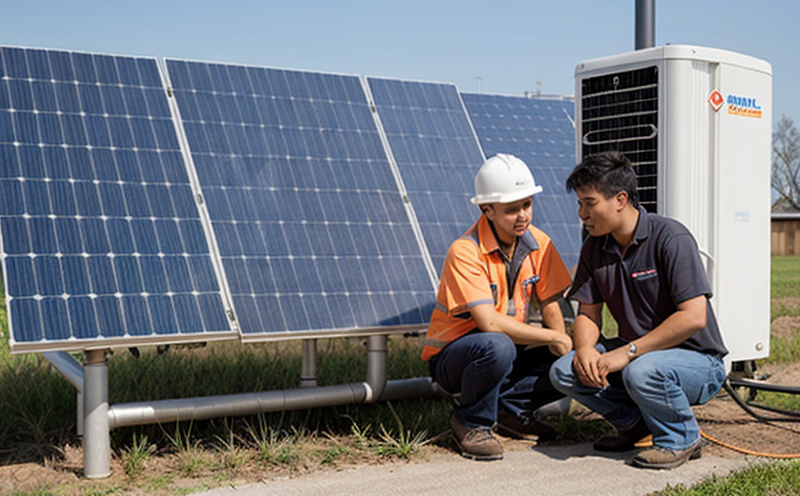Renewable energy inverter inspection
In the context of renewable energy systems, inverters play a critical role by converting direct current (DC) from photovoltaic solar panels or wind turbines into alternating current (AC), which can be used to power homes and businesses. Given their pivotal function in harnessing clean energy, it is imperative that these devices undergo stringent inspection and testing to ensure they meet the required standards for performance, safety, and reliability.
The inspection of renewable energy inverters involves a series of tests designed to evaluate various aspects such as efficiency, durability, compliance with international standards like IEC 61215 (PV modules), IEC 61404-2 (wind turbines), and UL 1741 (inverters). These tests are essential for ensuring that inverters operate efficiently under different environmental conditions while also meeting safety regulations.
During the inspection process, various parameters are measured including voltage stability, power factor correction, harmonic distortion levels, and efficiency across varying load conditions. The testing often simulates real-world scenarios to assess how well the inverter can handle fluctuations in input power or changes in ambient temperature. This comprehensive approach helps identify potential issues early on, preventing costly downtime and ensuring consistent performance over time.
For quality managers, compliance officers, R&D engineers, and procurement professionals working within this sector, understanding these nuances is crucial for making informed decisions about the selection, implementation, and maintenance of inverters in renewable energy projects. By adhering to rigorous inspection protocols, stakeholders can ensure that their systems are not only compliant with regulatory requirements but also optimized for maximum efficiency and longevity.
Why It Matters
The importance of renewable energy inverter inspection cannot be overstated. As the world transitions towards greater reliance on sustainable power sources, the role of inverters becomes even more critical. These devices are responsible for converting variable DC outputs from solar panels and wind turbines into stable AC that can be fed directly into electrical grids or used within buildings.
Efficient inverters not only improve energy yields but also contribute to reduced greenhouse gas emissions by maximizing electricity production from renewable sources. By ensuring that inverters meet stringent performance criteria, inspectors help prevent failures which could lead to costly repairs, environmental hazards due to potential fires or leaks, and disruptions in power supply.
Moreover, adhering to international standards such as IEC 61215 for PV modules and IEC 61404-2 for wind turbines ensures that inverters are safe and reliable. Compliance with these guidelines helps protect consumers by reducing the risk of accidents or malfunctions during operation.
For organizations involved in the design, manufacturing, installation, or maintenance of renewable energy systems, regular inspections serve as a vital tool for maintaining high levels of operational integrity. It enables them to identify areas where improvements can be made and implement best practices that enhance overall system performance. Ultimately, thorough inspection leads to more efficient operations, lower operating costs, enhanced safety standards, and better alignment with regulatory requirements.
Industry Applications
- Solar Power Plants: Ensuring that inverters in solar farms are functioning correctly is crucial for optimal power generation. Regular inspections help maintain peak performance and prevent costly downtime.
- Commercial Buildings: Inverters used in commercial buildings need to be reliable and efficient, especially those connected to rooftop solar systems. Inspection ensures they operate smoothly without compromising energy savings or occupant comfort.
- Residential Homes: For homeowners considering adding renewable energy sources like solar panels, having their inverters inspected before installation is advisable. This guarantees compatibility with existing electrical infrastructure and long-term reliability of the system.
- Offshore Wind Farms: Offshore wind turbines generate substantial amounts of electricity, much of which passes through inverters on platforms at sea. Inspecting these inverters regularly helps safeguard against malfunctions that could disrupt entire operations.
Why Choose This Test
The decision to conduct renewable energy inverter inspection is driven by several factors. Firstly, it aligns with global efforts towards sustainable development goals, emphasizing the importance of reducing reliance on fossil fuels and promoting cleaner forms of energy production.
In addition to environmental benefits, choosing this type of testing offers numerous practical advantages for businesses operating within the renewable energy sector:
- Enhanced Reliability: By identifying potential weaknesses early, organizations can address issues before they escalate into full-blown failures. This proactive approach enhances the overall reliability and longevity of inverter systems.
- Cost Savings: Preventive maintenance through regular inspections reduces unnecessary expenditures associated with unplanned repairs or replacements. It also minimizes downtime costs by catching problems early when they are easier and less expensive to fix.
- Increased Efficiency: Ensuring that inverters operate at optimal levels improves energy conversion rates, leading to increased power output from renewable sources. This results in better returns on investment for stakeholders involved in the project.
- Compliance Assurance: Adhering to relevant industry standards such as IEC 61215 and UL 1741 demonstrates commitment to high ethical standards and builds trust with customers, partners, and regulators.
In summary, choosing renewable energy inverter inspection is not just about meeting regulatory requirements; it’s an investment in future-proofing your operations against risks while maximizing the benefits of clean energy technologies.





